Insights on the Use of Pesticides in Two Main Food-Supplier Coastal Valleys of Lima City, Peru
Abstract
1. Introduction
2. Materials and Methods
2.1. Study Areas
- The valley of the Chancay-Huaral, which was shaped by the Chancay River originating in the western Andes of Raura (Canta province, Lima region). The Chancay River extends for approximately 120 km and has a watershed area of 3200 km2. This river discharges into the Pacific Ocean 77 km north of Lima City and 6 km south of the district of Chancay. The areas of the Chancay-Huaral valley under study were Retes, La Esperanza (Alta and Baja), Huayán, Jesús del Valle, La Huaca, Aucallama, Esquivel, Torre Blanca, Laure, and Chancayllo, as indicated in Figure 1.
- The valley of the Chillón River, which is located 20 km north of the center of Lima City. The Chillón River originates in the Chonta lagoon of the Andean mountains, province of Canta, and flows through the districts of Carabayllo, Puente Piedra, Ventanilla, and part of Comas, Los Olivos, and San Martín de Porras, all integrated in metropolitan Lima (Lima City). The river has a length of 126 km, a watershed area of 2444 km2, and discharges into the Pacific Ocean. The areas of the Chillón valley investigated were the current agricultural areas in the districts of Los Olivos, Comas, and Carabayllo (Figure 1).
2.2. Methods
2.2.1. Data Collection
- Socioeconomic aspects, which included questions on the age, gender, level of education, size of the property, landownership, availability of capital, and membership to an agriculture association.
- Occupational aspects, which included questions on crop and pest management, and information about pesticides used and practices in pesticide application. The participants were asked questions about the commercial name of the chemicals they use, on the dose of pesticides applied on crops, on the storage of such products, and on waste disposal. Additionally, questions about pesticide application methods, maintenance of the equipment used in the applications (leaks, repairs, etc.), and the use of personal protective equipment (PPE) (overall work clothing, gloves, and masks) were included. A sub-section on health was also included, with questions on a self-evaluation of health status, and on the number of years they were in contact with pesticides.
- Knowledge aspects, which included questions on the sources of information about pesticides, technical assistance and guidance for pesticide use, modality of access to such information, and knowledge on the meaning of the colors and symbols on pesticide labels.
2.2.2. Statistical Analysis
3. Results
3.1. Socioeconomic Aspects
3.2. Occupational Exposure Aspects
3.3. Knowledge Aspects
4. Discussion
4.1. Gender, Educational Level, Provenance, and Land Ownership
- (1)
- Large-scale farmers, owning more than 20 hectares. They make large capital investments in crops and technology, hire a significant workforce, and produce for export.
- (2)
- Medium-scale farmers, owning more than 5 and up to 20 hectares. They also make significant capital investments, but their families work in the field as well. Their products are mostly intended for the local market, mainly Lima city, but occasionally could be exported as well.
- (3)
- Small-scale farmers, owning up to 5 hectares of land. They lack financial resources to invest, and their families work in field and provide most of the labor. Often, these SSFs do not own land, but they lease it from third parties and they live on the land while performing their agricultural and complementary activities.
4.2. Socioeconomic and Educational Aspects and Risk of Exposure to Pesticides
4.3. Pesticide Residues, Farmers’ Education Level, and Waste Management Policy
4.4. Informal and Biased Agrochemical Advice to Farmers
4.5. Role of Official Agencies in Establishing Guidelines on Agrochemicals
4.6. Lifelong Exposure to Pesticides and Workers’ Health
5. Conclusions
Supplementary Materials
Author Contributions
Funding
Institutional Review Board Statement
Informed Consent Statement
Data Availability Statement
Acknowledgments
Conflicts of Interest
References
- Butler, R.A. The Top 10 Most Biodiverse Countries. Mongabay. 2016. Available online: https://news.mongabay.com/2016/05/top-10-biodiverse-countries/ (accessed on 15 May 2024).
- Pulgar-Vidal, J. Las ocho regiones naturales del Perú. Terra Brasilis. Rev. Rede Brasil. Hist. Geograf. e Geograf. Hist. 2014, 3. [Google Scholar] [CrossRef]
- INEI—Instituto Nacional de Estadística e Informática. Resultados Definitivos: IV Censo Nacional Agropecuario 2012; Instituto Nacional de Estadística e Informática: Lima, Peru, 2013; 63p. Available online: https://proyectos.inei.gob.pe/web/DocumentosPublicos/ResultadosFinalesIVCENAGRO.pdf (accessed on 17 March 2024).
- TE—Trading Economics. Peru: Agriculture, Value Added (% of GDP). Available online: https://tradingeconomics.com/peru/agriculture-value-added-percent-of-gdp-wb-data.html (accessed on 17 March 2024).
- Forbes Peru. Lima llega a los 10,2 Millones de Habitantes: Representa el 30,2% de la Población de Perú. Available online: https://forbes.pe/actualidad/2024-01-18/lima-llega-a-los-102-millones-de-habitantes-representa-el-302-de-la-poblacion-de-peru (accessed on 23 January 2024).
- INEI—Instituto Nacional de Estadística e Informática. Lima Supera los 10 Millones de Habitantes al año 2022. Available online: https://m.inei.gob.pe/prensa/noticias/lima-supera-los-10-millones-de-habitantes-al-ano-2022-13297/ (accessed on 24 January 2024).
- INEI—Instituto Nacional de Estadística e Informática. Encuesta Nacional Agropecuaria 2022. Available online: https://cdn.www.gob.pe/uploads/document/file/4896177/Principales%20Resultados%20%E2%80%93%20Peque%C3%B1as%20y%20Medianas%20Unidades%20Agropecuarias%2C%202014%20%E2%80%93%202019%20y%202021%20-%202022.pdf?v=1690213812 (accessed on 20 December 2023).
- Trivelli, C.; Escobal, J.; Revesz, B. La Pequeña Agricultura Comercial: Límites y Posibilidades para su Desarrollo. In Pequeña Agricultura Comercial: Dinámica y Retos en el Perú; Trivelli, C., Escobal, J., Revesz, B., Eds.; Instituto de Estudios Peruanos IEP: Lima, Peru, 2006; pp. 13–58. [Google Scholar]
- Buitrón, J.; Jara, B. Observatorio de la agricultura familiar en Perú. In Boletín de Agricultura Familiar de América Latina y el Caribe; Food and Agriculture Organization of the United Nations: Rome, Italy, 2013; Volume 6, pp. 4–6. [Google Scholar]
- Rosset, P.; Martínez, M. Soberanía alimentaria: Reclamo mundial del movimiento campesino. Ecofronteras 2014, 18, 8–11. Available online: https://revistas.ecosur.mx/ecofronteras/index.php/eco/article/view/1056 (accessed on 20 December 2023).
- Beyer-Arteaga, A.A.; Rodríguez-Quispe, P.; Collantes-González, R.D.; Joyo Coronado, G. Factores socioeconómicos, productivos y fuentes de información sobre plaguicidas para productores de Fragaria x ananassa en Cañete, Lima, Perú. Idesia 2017, 35, 31–37. [Google Scholar]
- INEI—Instituto Nacional de Estadística e Informática. Perú: Crecimiento y Distribución de la Población, 2007; Instituto Nacional de Estadística e Informática: Lima, Peru, 2008; 34p.
- Montoro, Y.; Moreno, R.; Gomero, L.; Reyes, M. Características de uso de plaguicidas químicos y riesgos para la salud en agricultores de la sierra central del Perú. Rev. Peru Med. Exp. Salud Pública 2009, 26, 466–472. [Google Scholar]
- Sarabia-Núñez, C.; Negrón-Ballarte, L.; Melendez-Serrano, M.d.C.; Pérez-Gonzalez, R.M. Estudio bioquímico-clínico en personas ocupacionalmente expuestas a la acción de agroquímicos y efectos de su uso frecuente sobre la salud. Cienc. Investig. UNMSM 1998, 1, 1–18. [Google Scholar] [CrossRef]
- SENASA—Servicio Nacional de Sanidad Agraria CONAM—Consejo Nacional del Ambiente DIGESA—Dirección General de Salud Ambiental Inventario Nacional de Plaguicidas, C.O.P. Proyecto GEF/PNUMA N° GFL-2328—2761—4747, Lima. 2006. Available online: https://www.researchgate.net/profile/Alfonso-Lizarraga-Travaglini/publication/312889535_Inventario_Nacional_de_Plaguicidas_COP_-_Peru/links/5888c96192851c06a133cebc/Inventario-Nacional-de-Plaguicidas-COP-Peru.pdf?_tp=eyJjb250ZXh0Ijp7ImZpcnN0UGFnZSI6InB1YmxpY2F0aW9uIiwicGFnZSI6InB1YmxpY2F0aW9uIn19 (accessed on 20 December 2023).
- Zaldívar, R. La ganadería peruana frente al uso de plaguicidas. Rev. Peru. Entomología 1986, 29, 7–19. [Google Scholar]
- MINAG—Ministerio de Agricultura y Riego. Anuario Estadístico—Medios de Producción Agropecuarios. 2016. Available online: https://siea.midagri.gob.pe/portal/phocadownload/datos_estadisticas/anuarios/insumos_servicios/insumos_servicios_2016.pdf (accessed on 15 May 2024).
- Chavarro, J. Región Andina: Importaciones de Agroquímicos Aumentan con Fungicidas como Principal unidad de Negocio. Agri Business Global, Julio. 2021. Available online: https://www.agribusinessglobal.com/es/agroquimicos/region-andina-importaciones-de-agroquimicos-escalada-con-fungicidas-como-unidad-de-negocio-principal/ (accessed on 15 May 2024).
- OEC—Observatory of Economic Complexity. Pesticides in Peru. Available online: https://oec.world/en/profile/bilateral-product/pesticides/reporter/per (accessed on 15 May 2024).
- MINSA—Ministerio de Salud. Vigilancia Epidemiológica del Riesgo de Exposición e Intoxicación por Plaguicidas: Perú a la SE 28—2022. Centro Nacional de Epidemiologia, Prevención y Control de Enfermedades del Ministerio de Salud. Available online: https://www.dge.gob.pe/portal/docs/vigilancia/sala/2022/SE28/plaguicidas.pdf (accessed on 20 December 2023).
- Chávez-Dulanto, P.N.; Thiry, A.A.; Glorio-Paulet, P.; Vögler, O.; Carvalho, F.P. Increasing the impact of science and technology to provide more people with healthier and safer food. Food Energy Secur. 2021, 10, e259. [Google Scholar] [CrossRef]
- Porta-Lozano, J.A. Prevalencia de Intoxicaciones Producidas por el uso de Plaguicidas en la Población agrícola del Distrito de Huacrapuquio-Huancayo Enero-Octubre 2018. Bachelor’s Thesis, Universidad Peruana Los Andes, Huancayo, Peru, 2021. Available online: https://repositorio.upla.edu.pe/bitstream/handle/20.500.12848/1992/TESIS%20FINAL.pdf?sequenc (accessed on 24 January 2024).
- Núñez Borja, J. Intoxicaciones por Plaguicidas en los Fumigadores y Medidas Preventivas de Enfermería en el Puesto de Salud Virgen de las Mercedes, Supe. Bachelor’s Thesis, Universidad Nacional Faustino Sánchez Carrión, Huacho, Peru, 2021. Available online: https://repositorio.unjfsc.edu.pe/bitstream/handle/20.500.14067/4562/JUNIOR%20N%C3%9A%C3%91EZ%20BORJA.pdf?sequence=1&isAllowed=y (accessed on 24 January 2024).
- Cotrina, G.G.; Nolberto ED, E.; Huachos KM, H.; Chávez, M.P.; Ávila LY, M. Uso de Plaguicidas Químicos en el cultivo de Papa (Solanum tuberosum L), su relación con Medio Ambiente y la Salud. CPAH Sci. J. Health 2022, 5, 49–70. [Google Scholar]
- Tarazona-Tineo, J.F. Evaluación y Consecuencias de los Plaguicidas en la Salud de los Pobladores de Mala, Perú. Bachelor’s Thesis, Universidad Peruana Norbert Wiener, Lima, Peru, 2022. Available online: https://repositorio.uwiener.edu.pe/bitstream/handle/20.500.13053/7284/T061_62384260_T.pdf?sequence=1 (accessed on 24 January 2024).
- FAO—Food and Agriculture Organization of the United Nations. Pest and Pesticide Management. 2024. Available online: https://www.fao.org/pest-and-pesticide-management/about/understanding-the-context/en/ (accessed on 23 January 2024).
- Taylor, M.D.; Klaine, S.J.; Carvalho, F.P.; Barcelo, D.; Everaarts, J. (Eds.) Pesticide Residues in Coastal Tropical Ecosystems. Distribution, Fate and Effects; Taylor & Francis Publ., CRC Press: London, UK, 2003; 576p, ISBN 0-415-23917-6. [Google Scholar]
- Carvalho, F.P. Pesticides, Environment, and Food Safety. Food Energy Secur. 2017, 6, 48–60. [Google Scholar] [CrossRef]
- De Roos, A.J.; Schinasi, L.H.; Miligi, L.; Cerhan, J.R.; Bhatti, P.; ‘t Mannetje, A.; Baris, D.; Benavente, Y.; Benke, G.; Clavel, J.; et al. Occupational insecticide exposure and risk of non-Hodgkin lymphoma: A pooled case-control study from the InterLymph Consortium. Int. J. Cancer 2021, 149, 1768–1786. [Google Scholar] [CrossRef]
- Gonzáles-Tipiana, I.R.; Rubianes-Huamán, A.G.; del Carmen Sobrevilla-Huamán, A. Prevalencia y riesgo de malformación congénita en mujeres gestantes expuestas a plaguicidas en el Hospital Regional de Ica, Perú. Rev. Méd. Panacea 2017, 5, 52–56. [Google Scholar]
- Honles, J.; Clisson, C.; Monge, C.; Vásquez-Ocmín, P.; Cerapio, J.P.; Palamy, S.; Casavilca-Zambrano, S.; Herrera, J.; Pineau, P.; Deharo, E.; et al. Exposure assessment of 170 pesticide ingredients and derivative metabolites in people from the Central Andes of Peru. Sci. Rep. 2022, 12, 13525. [Google Scholar] [CrossRef] [PubMed]
- Raimi, M.O.; Vivien, O.T.; Alima, O.; Akpojubaro, E.H.; Williams, E.A. Articulating the effect of pesticides use and sustainable development goals (SDGs): The science of improving lives through decision impacts. Res. World Agric. Econ. 2021, 2, 29–36. [Google Scholar] [CrossRef]
- Shahmohamadloo, R.S.; Febria, C.M.; Fraser, E.D.; Sibley, P.K. The sustainable agriculture imperative: A perspective on the need for an agrosystem approach to meet the United Nations Sustainable Development Goals by 2030. Integr. Environ. Assess. Manag. 2022, 18, 1199–1205. [Google Scholar] [CrossRef] [PubMed]
- Zhang, Z.; Yan, X.; Jones, K.C.; Jiao, C.; Sun, C.; Liu, Y.; Zhu, Y.; Zhang, Q.; Zhai, L.; Shen, Z.; et al. Pesticide risk constraints to achieving Sustainable Development Goals in China based on national modeling. NPJ Clean Water 2022, 5, 59. [Google Scholar] [CrossRef]
- Tudi, M.; Li, H.; Li, H.; Wang, L.; Lyu, J.; Yang, L.; Tong, S.; Yu, Q.J.; Ruan, H.D.; Atabila, A.; et al. Exposure Routes and Health Risks Associated with Pesticide Application. Toxics 2022, 10, 355. [Google Scholar] [CrossRef]
- Vercruysse, F.; Drieghe, S.; Steurbaut, W.; Dejonckheere, W. Exposure assessment of professional pesticide users during treatment of potato fields. Pestic. Sci. 1999, 55, 467–473. [Google Scholar] [CrossRef]
- Edwards, P.; Roberts, I.; Clarke, M.; DiGuiseppi, C.; Pratap, S.; Wentz, R.; Kwan, I. Increasing response rates to postal questionnaires: Systematic review. Br. Med. J. 2002, 324, 1183–1926. [Google Scholar] [CrossRef]
- Nieuwenhuijsen, M.J. Design of exposure questionnaires for epidemiological studies. Occup. Environ. Med. 2005, 62, 272–280. [Google Scholar] [CrossRef]
- Corbetta, P. Metodología y téCnicas de Investigación Social; McGraw-Hill/Interamericana de España, SAU: Madrid, Spain, 2007; 304p. [Google Scholar]
- Wagner, C.H.; Cox, M.; Bazo-Robles, J.L. Pesticide lock-in in small scale Peruvian agriculture. Ecol. Econ. 2016, 129, 72–81. [Google Scholar] [CrossRef]
- Galagarza, O.A.; Ramirez-Hernandez, A.; Oliver, H.F.; Álvarez Rodríguez, M.V.; Valdez Ortiz, M.D.C.; Pachari-Vera, E.; Cereceda, Y.; Díaz-Valencia, Y.K.; Deering, A.J. Occurrence of chemical contaminants in Peruvian produce: A food-safety perspective. Foods 2021, 10, 1461. [Google Scholar] [CrossRef] [PubMed]
- Mera-Orcés, V. Agroecosystems Management, Social Practices and Health: A Case Study on Pesticide Use and Gender in the Ecuadorian Highlands; A Technical Report to the IDRC. Canadian-CGIAR Ecosystem Approaches to Human Health Training Awards with a Particular Focus on Gender; International Development Research Centre—IDRC: Ottawa, ON, Canada, 2000; 39p.
- Crissman, C.C.; Espinosa, P.; Ducrot, C.; Cole, D.C.; Carpio, F. The Case Study Site: Physical, Health and Potato Farming Systems in Carchi Province. Chapter 5. In Quantifying Tradeoffs in the Environment, Health and Sustainable Agriculture: Pesticide Use in the Andes; Crissman, C.C., Capalbo, S.M., Eds.; Kluwer Academic Press: Boston, MA, USA, 1998; pp. 85–120. [Google Scholar]
- Yangenn, D.; Crissman, C.; Espinosa, P. Los Plaguicidas: Impactos en Producción, Salud y Medio Ambiente en Carchi, Ecuador; International Potato Center—CIP, Instituto Nacional Autónomo de Investigaciones Agro-Pecuarias—INIAP. Edic. Abya Ayala: Lima, Peru, 2003; 198p.
- Viteri-Bonilla, F.J. Estudio Bioquímico Clínico de la Exposición a Plaguicidas Organofosforados y Carbamatos Sobre el perfil Hepático en Agricultores de la Parroquia de San Luís Cantón, Riobamba, Provincia de Chimborazo. Bachelor’s Thesis, Escuela Superior Politécnica de Chimborazo, Riobamba, Ecuador, 2015. [Google Scholar]
- Marañón-Calderón, P.G. Manejo y Uso de los Plaguicidas Agrícolas entre los Horticultores en el valle del río Chillón. Lima, Perú. Grade Thesis, Universidad Nacional Agraria La Molina, Lima, Peru, 2015. Available online: https://repositorio.lamolina.edu.pe/bitstream/handle/20.500.12996/2102/H10-M373-T.pdf?sequence=1&isAllowed=y (accessed on 12 December 2023).
- Cruz Escalón, A. Situación Actual del Consumo de Pesticidas en el Perú. Bachelor’s Thesis, Universidad Nacional Agraria La Molina, Peru, Lima, 2017. Available online: http://repositorio.lamolina.edu.pe/bitstream/handle/UNALM/2976/E71-C7-T.pdf?sequence=1 (accessed on 12 December 2023).
- CL—Campo Limpio. Campo Limpio Aspira a Recuperar Hasta 45% del Plástico usado para Envases de Agroquímicos en el 2021. Available online: http://campolimpio.org.pe/2017/07/24/campo-limpio-aspira-a-recuperar-hasta-45-del-plastico-usado-para-envases-de-agroquimicos-en-el-2021/ (accessed on 12 December 2023).
- SENASA—Servicio Nacional de Sanidad Agraria. Plaguicidas Restringidos y Prohibidos en el Perú. Available online: https://cdn.www.gob.pe/uploads/document/file/1676339/LISTADO.pdf.pdf (accessed on 21 January 2024).
- Dulanto Valdivieso, C.H. Variables Epidemiológicas en la Intoxicación por Fumigación con Organofosforados en el valle de Chancay (1192–1997). Master’s Thesis, Escuela de Post Grado, Facultad de Medicina Humana, Universidad Nacional Mayor de San Marcos, Lima, Peru, 1999. [Google Scholar]
- Yengle, M.; Palhua, R.; Lescano, P.; Villanueva, E.; Chachi, E.; Yana, E.; Zaravia, R.; Ambrosio, J.; Clemente, J.; Cornejo, J.; et al. Prácticas de utilización de plaguicidas en agricultores en el distrito de Huaral—Perú. Rev. Peru. Epidemiol. 2008, 12, 1–6. [Google Scholar]
- Lacorte, S.; Ballesteros, R.; Colomer, P.; Zapata, P.; Delgado, A.; Martrat, G.; Abad, E.; Díez, S.; Santos, F.J.; Bertolero, A. Control de Contaminantes Orgánicos persistentes según Convenio de Estocolmo y Mercurio en Huevos de Láridos: Bases de datos, Series Históricas y Gestión Ambiental. Available online: https://www.miteco.gob.es/es/red-parques-nacionales/programa-investigacion/Contaminantes_mercurio_laridos.aspx (accessed on 10 December 2023).
- Sánchez, A.I.; Hernando, M.D.; Vaquero, J.J.; García, E.; Navas, J.M. Hazard assessment of alternatives to dicofol. J. Environ. Protect. 2010, 1, 231. [Google Scholar] [CrossRef]
- 20minutos. España deja de Fabricar Dicofol, un Agente Químico Perjudicial para la Salud. 2008. Available online: http://www.20minutos.es/noticia/368719/0/fabricacion/quimico/dicofol/ (accessed on 21 January 2024).
- MITECO—Ministerio para la Transición Tecnológica y el Reto Demográfico. Plan Nacional de Aplicación de, C.O.P. Red Nacional de Vigilancia Ambiental de COP. Available online: https://www.miteco.gob.es/es/calidad-y-evaluacion-ambiental/temas/productos-quimicos/contaminantes-organicos-persistentes-cop/plan_nacional.html (accessed on 22 March 2024).
- RC—Rotterdam Convention. Countries—Status of Ratifications. 2018. Available online: http://www.pic.int/Countries/Statusofratifications/tabid/1072/language/en-US/Default.aspx (accessed on 21 January 2024).
- SC—Stockholm Convention. Countries—Status of Ratification. 2018. Available online: http://chm.pops.int/Countries/StatusofRatifications/PartiesandSignatoires/tabid/4500/Default.aspx (accessed on 21 January 2024).
- MINSA—Ministerio de Salud. Prohíben uso y Comercio de Insecticida Clorpirifos en el Perú. 2023. Available online: https://www.gob.pe/institucion/minsa/noticias/797814-prohiben-uso-y-comercio-de-insecticida-clorpirifos-en-el-peru (accessed on 24 January 2024).
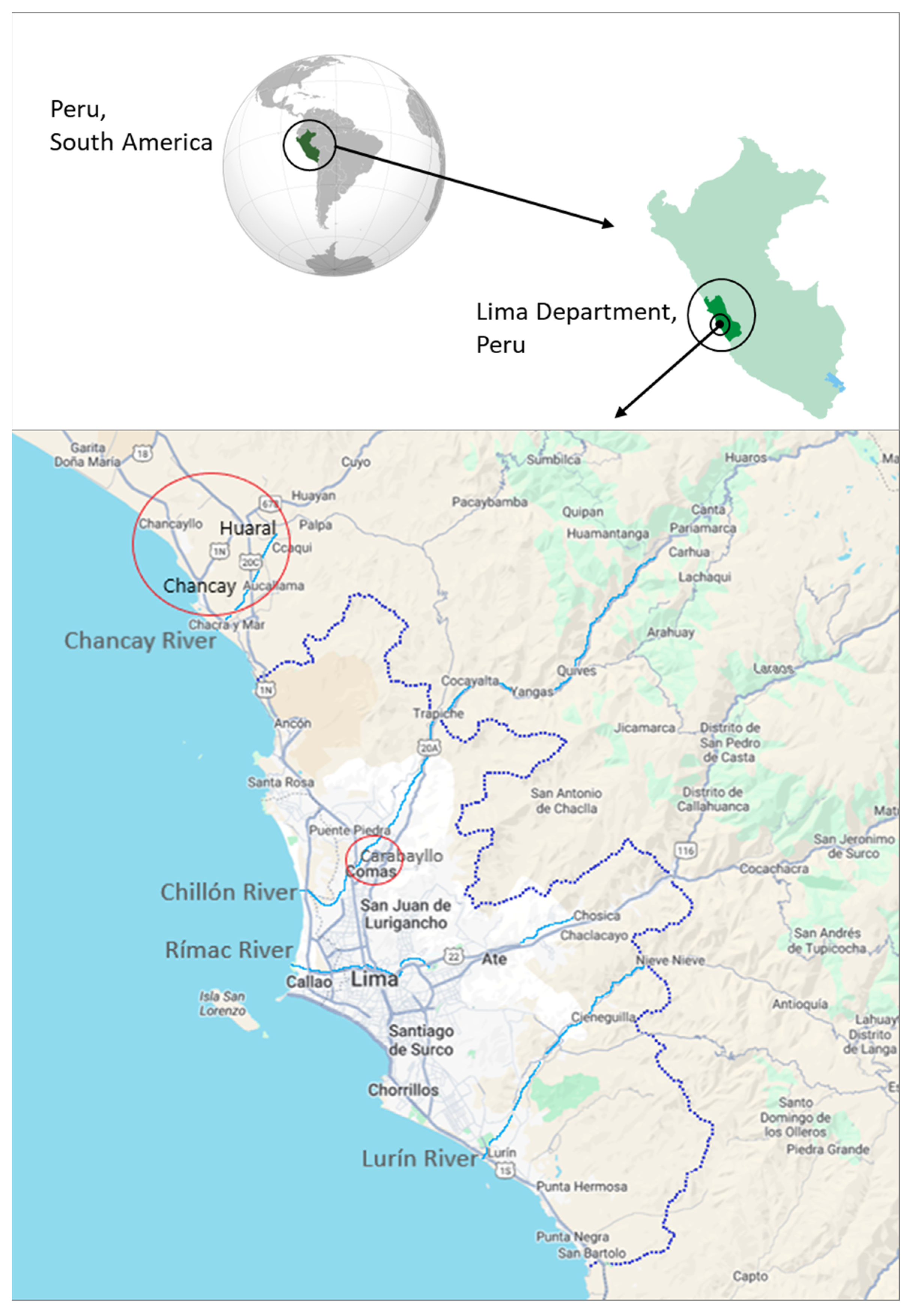
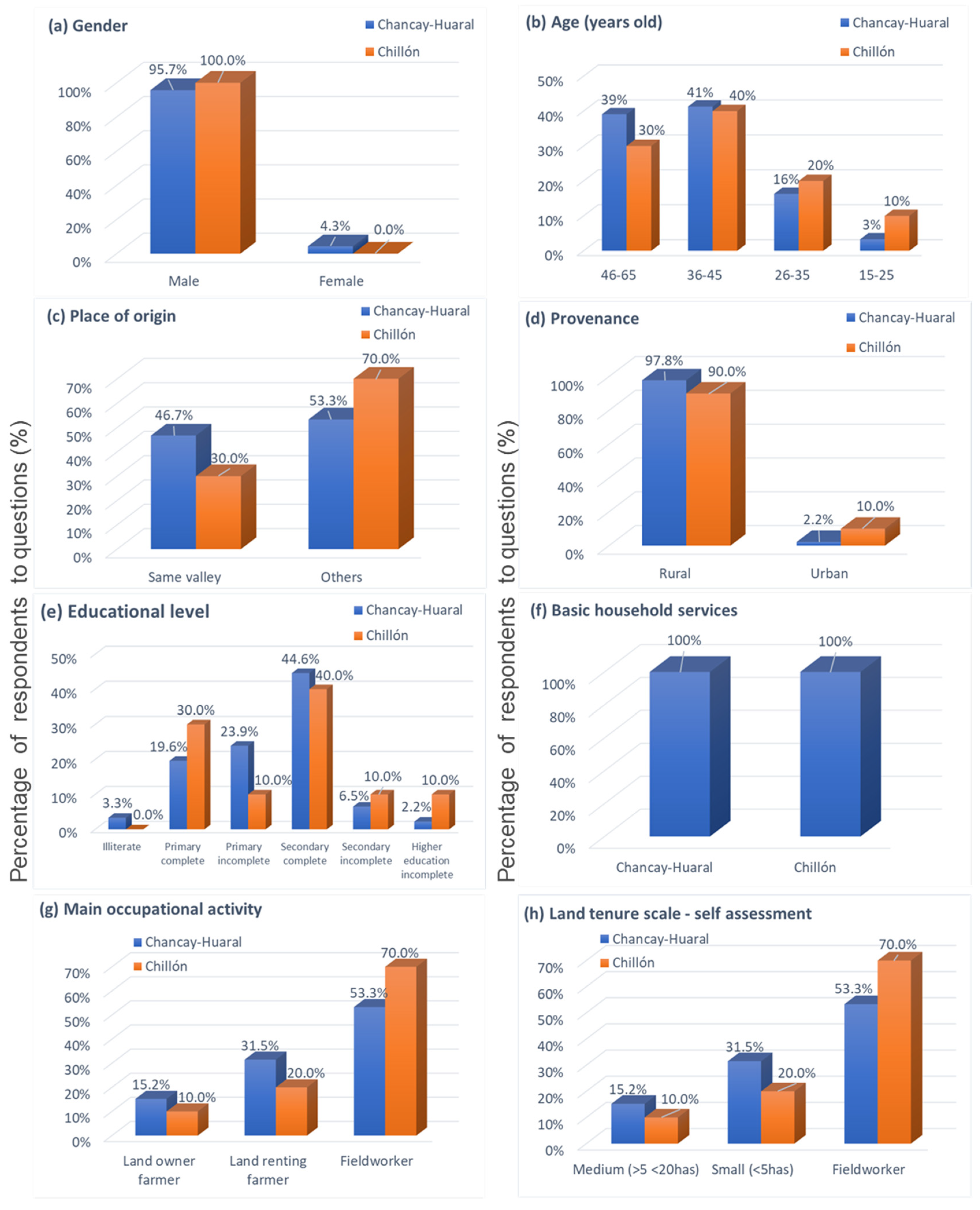
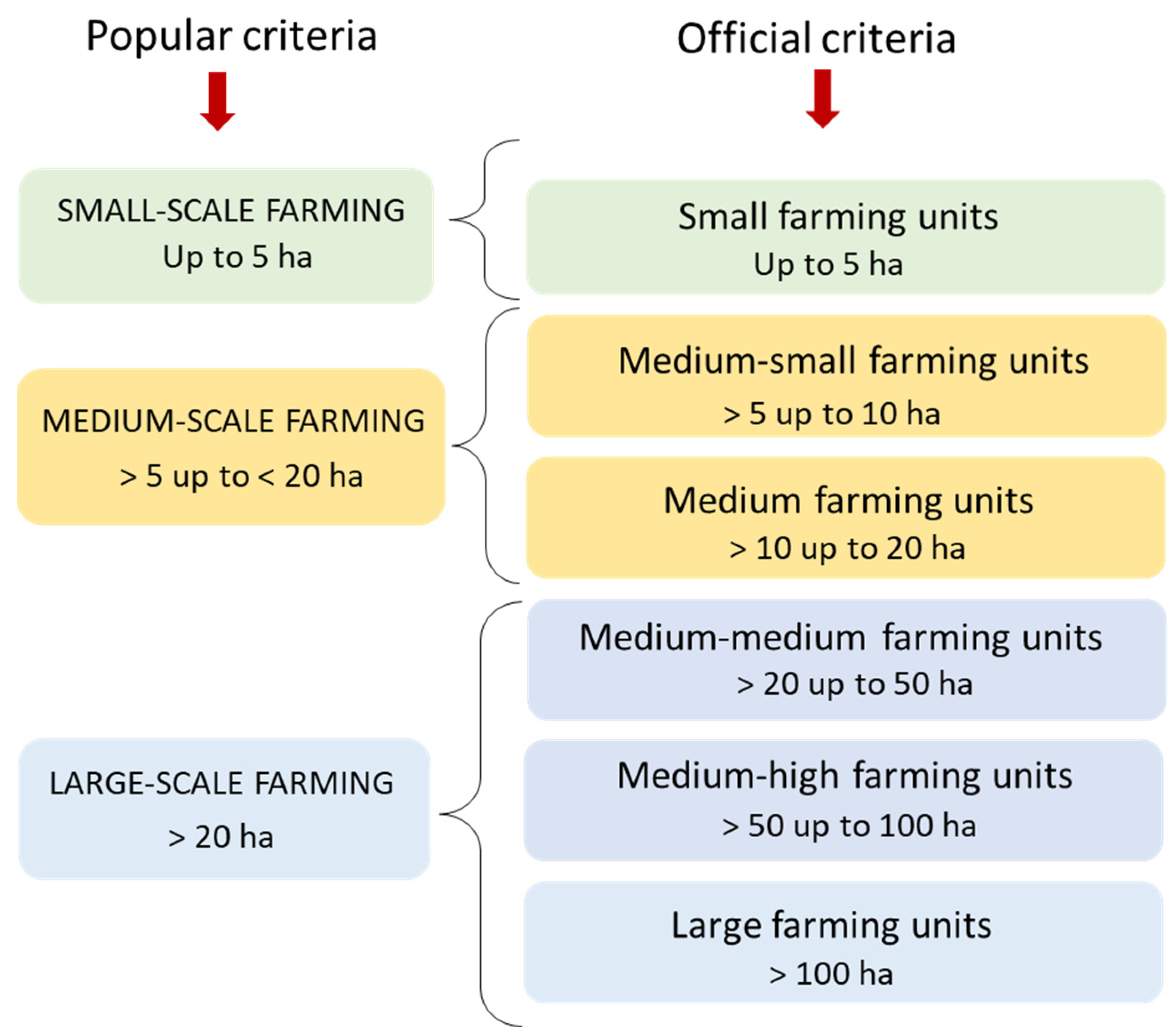

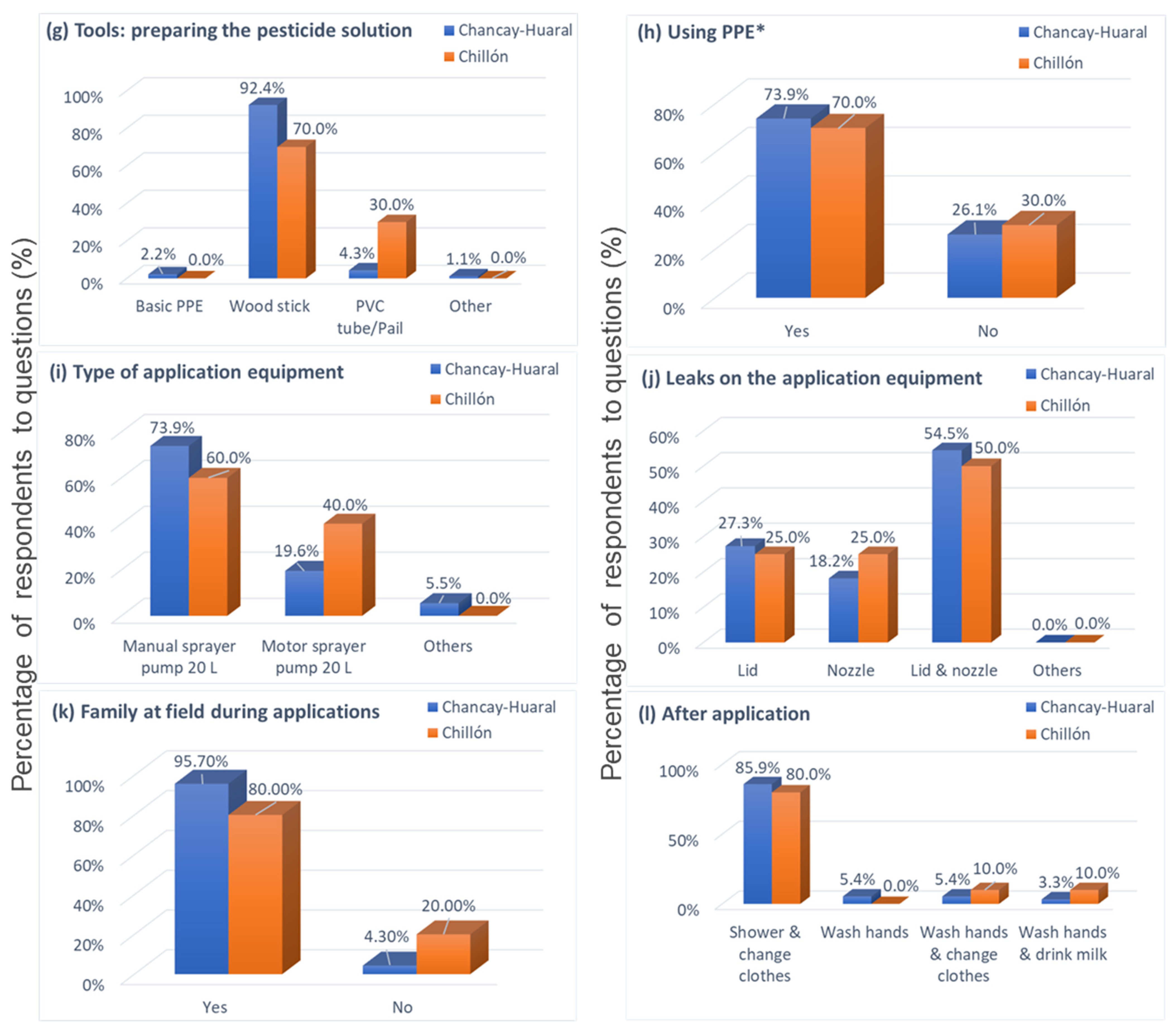
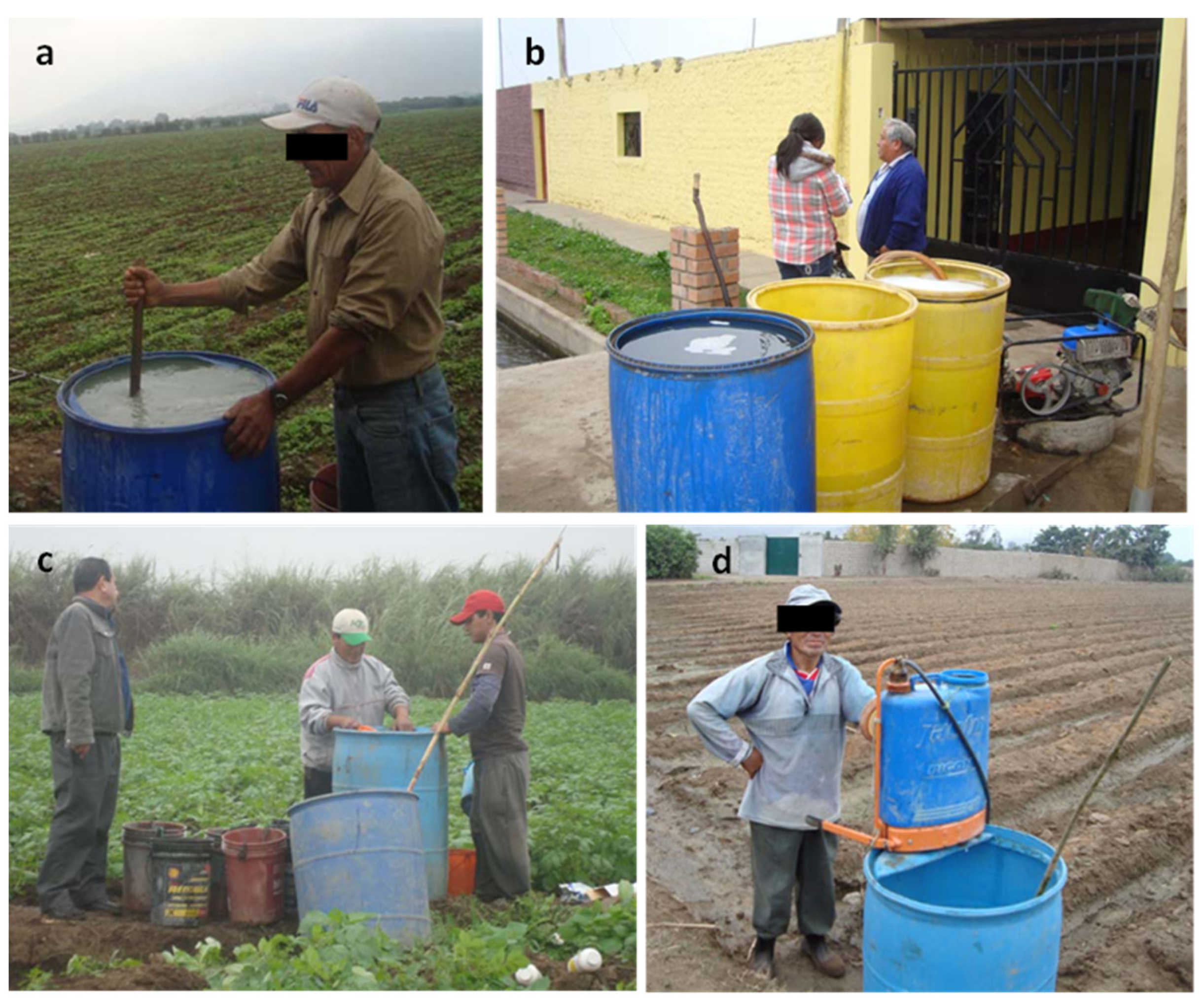
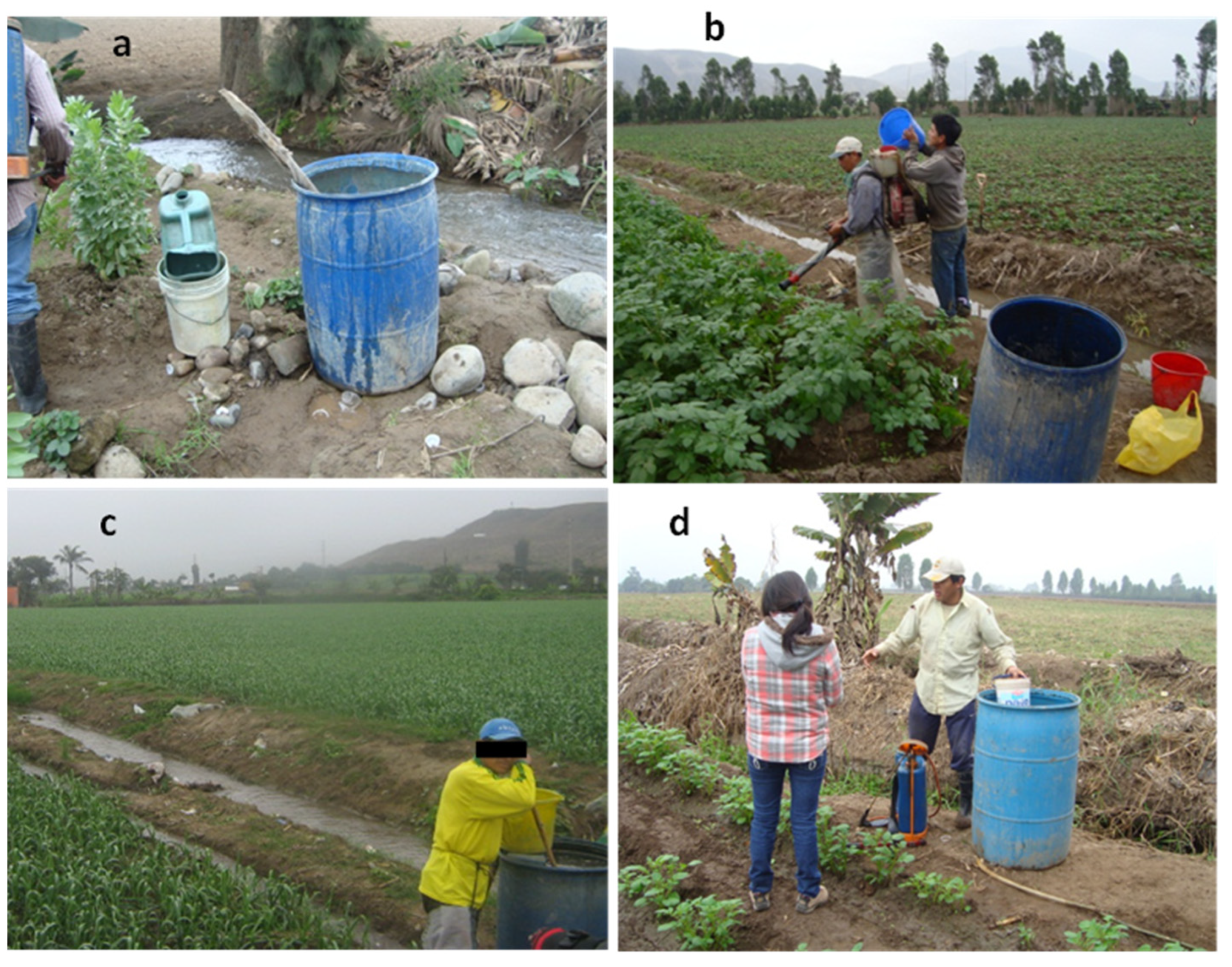

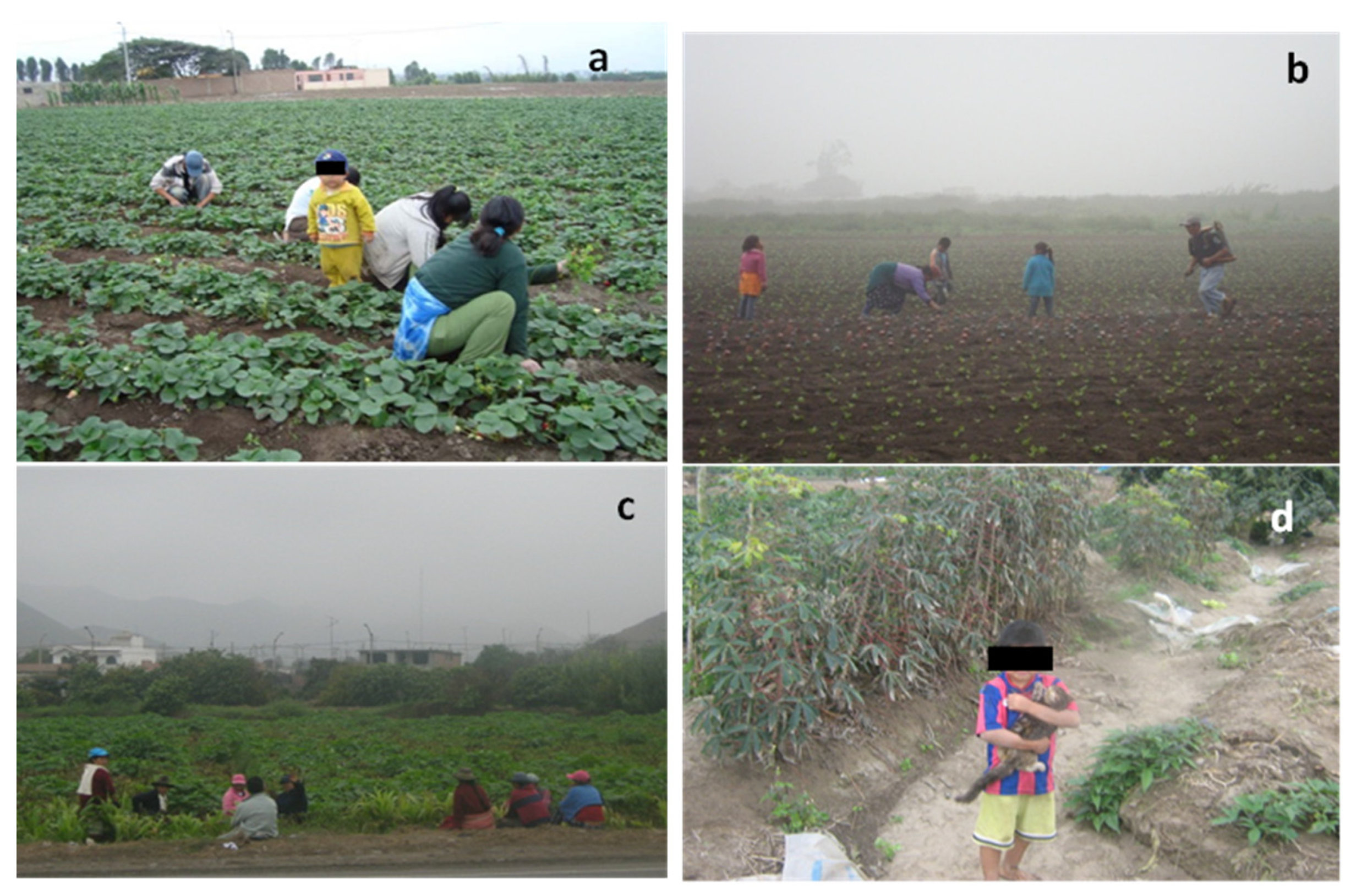

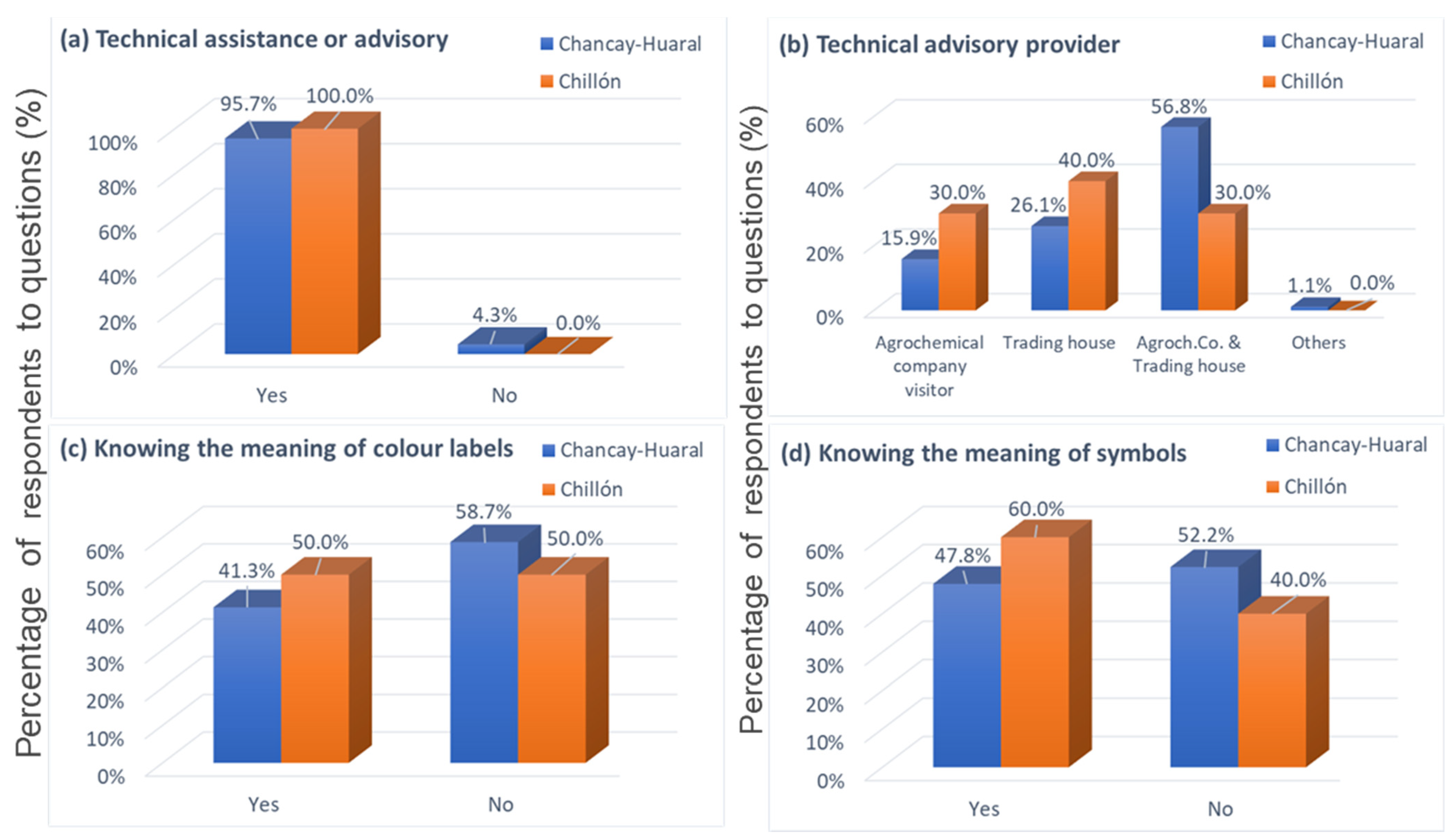
| N° | Active Ingredient of Pesticides | Type of Pesticide and Chemical Group | Average Number of Participants Reporting Its Use | Environmental Fate | Ecotoxicity Fate | Human Health |
|---|---|---|---|---|---|---|
| 1 | Methomyl | Insecticide, carbamate | 27.3 *** | High alert Solubility in water at 20 °C: 55,000 mg L−1; in organic solvents: 1,000,000 mg L−1 | High alert Bird acute LD50: 24.02 mg kg−1. Honeybee contact acute LD50: 0.16 μg bee−1. Acute and chronic toxicity for fauna. | High alert Mammal acute oral LD50: 30 mg kg−1. Endocrine disrupter; acetyl cholinesterase inhibitor |
| 2 | Methamidophos | Insecticide, organophosphate | 22.7 ** | High alert Drain flow very mobile Solubility at 20 °C in water: 200,000 mg L−1; in organic solvents: 200,000 mg L−1 | High alert Bird acute LD50: 10 mg kg−1. Honeybee oral acute LD50: >0.22 μg bee−1. Acute contact and oral toxicity for fauna. | High alert Mammal acute oral LD50: 30 mg kg−1. Genotoxic; acetyl cholinesterase inhibitor; neurotoxicant |
| 3 | Chlorpyrifos | Insecticide, organophosphate | 18.7 ** | Moderate alert Solubility at 20 °C in water: 1.05 mg L−1; in organic solvents: 4,000,000 mg L−1 | High alert Bird acute LD50: 39.2 mg kg−1. Honeybee contact acute LD50: 0.062 μg bee−1. Acute oral and chronic toxicity for fauna. | High alert Mammal acute oral LD50: 66 mg kg−1. Chronic toxicity; endocrine disrupter; reproduction/development effects; acetyl cholinesterase inhibitor; neurotoxicant |
| 4 | Alpha-cypermethrin | Insecticide, pyrethroid | 16.0 | Moderate alert Solubility at 20 °C in water: 0.004 mg L−1; in organic solvents: 596,000 mg L−1 | High alert Bird acute LD50: >2025 mg kg−1. Honeybee contact acute LD50: 0.033 μg bee−1. Acute contact and oral toxicity for fauna. | High alert Mammal acute oral LD50: 40 mg kg−1 |
| 5 | Cyromazine | Insecticide, triazine | 15.3 | Moderate alert Solubility at 20 °C in water: 13,000 mg L−1; in organic solvents: 17,000 mg L−1 | Moderate alert Bird acute LD50: >1785 mg kg−1. Honeybee oral acute LD50: 186 μg bee−1. Chronic toxicity for fauna. | High alert Mammal acute oral LD50: 3387 mg kg−1. Reproduction/developmental effects |
| 6 | Abamectin | Insecticide and acaricide, avermectin | 14.0 | Moderate alert Solubility at 20 °C in water: 7800 mg L−1; in organic solvents: 100,000 mg L−1 | Moderate alert Bird acute LD50: 2000 mg kg−1. High alert Honeybee oral acute LD50: 0.408 μg bee−1. | High alert Mammal acute oral LD50: 1.5 mg kg−1. Nervous system depression |
| 7 | Glyphosate | Herbicide, OP phosphonate | 11.3 | High alert Solubility at 20 °C in water: 100,000 mg L−1; in organic solvents: 10 mg L−1 | Moderate alert Bird acute LD50: >2000 mg kg−1. Honeybee contact acute LD50: >100 μg bee−1. Chronic toxicity for fauna. | High alert Mammal acute oral LD50: >2000 mg kg−1. Genotoxic |
| 8 | Dimethoate | Insecticide and acaricide, organophosphate | 11.3 | High alert Solubility at 20 °C in water: 25,900 mg L−1; in organic solvents: 1,030,000 mg L−1 | High alert Bird acute LD50: 10.5 mg kg−1. Honeybee contact acute LD50: 0.1 μg bee−1. | High alert Mammal acute oral LD50: 245 mg kg−1. Chronic toxicity; acetyl cholinesterase inhibitor |
| 9 | Cymoxanil + mancozeb | Fungicide, di-thiocarbamate | 11.3 | High alert Solubility at 20 °C in water: 780 mg L−1; in organic solvents: 62,400 mg L−1 | Moderate alert Bird acute LD50: >486 mg kg−1. Honeybee oral acute LD50: >85 μg bee−1. Acute and chronic toxicity for fauna. | High alert Mammal acute oral LD50: 356 mg kg−1. Genotoxic; reproduction/developmental effects |
| 10 | Trichlorfon | Insecticide, organophosphate | 8.7 | High alert Solubility at 20 °C in water: 120,000 mg L−1; in organic solvents: 1,346,000 mg L−1 | Moderate alert Bird acute LD50: >36.8 mg kg−1. Honeybee oral acute LD50: >0.4 μg bee−1 | High alert Mammal acute oral LD50: 212 mg kg−1. Genotoxic; endocrine disrupter; acetyl cholinesterase inhibitor; neurotoxicant |
| 11 | Propineb | Fungicide, di-thiocarbamate | 8.7 | Low alert Solubility at 20 °C in water: 10 mg L−1; in organic solvents: 100 mg L−1 | Moderate alert Bird acute LD50: >5000 mg kg−1. Honeybee contact acute LD50: >100 μg bee−1. Chronic toxicity for fauna. | Moderate alert Mammal acute oral LD50: >5000 mg kg−1. Possible carcinogen; endocrine disrupter; reproduction/developmental effects |
| 12 | Dimethomorph + mancozeb | Fungicide, morpholine + di-thiocarbamate | 8.0 | Moderate alert Solubility at 20 °C in water: 28.95 mg L−1; in organic solvents: 100,400 mg L−1 | Moderate alert Bird acute LD50: >2000 mg kg−1. Honeybee oral acute LD50: >32.4 μg bee−1. Chronic toxicity for fauna. | Moderate alert Mammal acute oral LD50: 3900 mg kg−1. Genotoxic; reproduction/developmental effects |
| 13 | Carbofuran | Insecticide, carbamate | 8.0 | Moderate alert Solubility at 20 °C in water: 322 mg L−1; in organic solvents: 105,200 mg L−1 | High alert Bird acute LD50: 0.71 mg kg−1. Honeybee contact acute LD50: 0.036 μg bee−1. Acute toxicity for fauna. | High alert Mammal acute oral LD50: 3900 mg kg−1. Endocrine disrupter; reproduction/developmental effects |
| 14 | Metribuzin | Herbicide, triazinona | 7.3 | High alert Solubility at 20 °C in water: 10,700 mg L−1; in organic solvents: 449,400 mg L−1 | High alert Bird acute LD50: 164 mg kg−1. Honeybee oral acute LD50: 76.7 μg bee−1. Acute toxicity for fauna. | High alert Mammal acute oral LD50: 322 mg kg−1. Endocrine disrupter; reproduction/developmental effects |
| 15 | Buprofezin | Insecticide, tiadiazina | 7.3 | Moderate alert Solubility at 20 °C in water: 0.637 mg L−1; in organic solvents: 520,000 mg L−1 | Moderate alert Bird acute LD50: >2000 mg kg−1. Honeybee oral acute LD50: >163.5 μg bee−1. Chronic toxicity for fauna. | Moderate alert Mammal acute oral LD50: >1635 mg kg−1. Possible carcinogen; reproduction/developmental effects |
| 16 | Benomyl | Fungicide, benzimidazole | 7.3 | Moderate alert Solubility at 20 °C in water: 2 mg L−1; in organic solvents: 94,000 mg L−1 | Moderate alert Bird acute LD50: 1000 mg kg−1. Honeybee contact acute LD50: 10 μg bee−1. Acute toxicity for fauna. | High alert Mammal acute oral LD50: >10,000 mg kg−1. Genotoxic; endocrine disrupter; reproduction/developmental effects |
| 17 | Tebuconazole | Fungicide, triazole | 6.7 | Moderate alert Solubility at 20 °C in water: 36 mg L−1; in organic solvents: 200,000 mg L−1 | High alert Bird acute LD50: 1988 mg kg−1. Honeybee oral acute LD50: 83.05 μg bee−1. Chronic toxicity for fauna. | High alert Mammal acute oral LD50: 1700 mg kg−1. Endocrine disrupter |
| 18 | Imidacloprid | Insecticide, neonicotinoid | 6.7 | High alert Solubility at 20 °C in water: 610 mg L−1; in organic solvents: 67,000 mg L−1 | High alert Bird acute LD50: 31 mg kg−1. Honeybee oral acute LD50: 0.0037 μg bee−1. Acute and chronic toxicity for fauna. | High alert Mammal acute oral LD50: 131 mg kg−1. Reproduction/developmental effects |
| 19 | Cyfluthrin | Insecticide, pyrethroid | 6.7 | Moderate alert Solubility at 20 °C in water: 0.0066 mg L−1; in organic solvents: 200,000 mg L−1 | High alert Bird acute LD50: >2000 mg kg−1. Honeybee contact acute LD50: 0.001 μg bee−1. Acute and chronic toxicity for fauna. | High alert Mammal acute oral LD50: >16.2 mg kg−1. Neurotoxicant |
| 20 | Cyhexatin | Insecticide, tin derivatives | 6.7 | High alert Solubility at 20 °C in water: 1.0 mg L−1; in organic solvents: 216,000 mg L−1 | High alert Bird acute LD50: 520 mg kg−1. Honeybee contact acute LD50: 32 μg bee−1. Acute and chronic toxicity for fauna. | Moderate alert Mammal acute oral LD50: 265 mg kg−1. Reproduction/developmental effects |
| 21 | Carbendazim | Fungicide, carbamate | 6.0 | Moderate alert Solubility at 20 °C in water: 8.0 mg L−1; in organic solvents: 300 mg L−1 | High alert Bird acute LD50: 2250 mg kg−1. Honeybee contact acute LD50: >50 μg bee−1. Acute and chronic toxicity for fauna. | High alert Mammal acute oral LD50: >10,000 mg kg−1. Genotoxic; endocrine disrupter; reproduction/developmental effects |
| 22 | Aldicarb | Insecticide, carbamate | 6.0 | High alert Solubility at 20 °C in water: 4930 mg L−1; in organic solvents: 470,000 mg L−1 | High alert Bird acute LD50: 3.4 mg kg−1. Honeybee oral acute LD50: >0.16 μg bee−1. Acute toxicity for fauna. | High alert Mammal acute oral LD50: 0.93 mg kg−1. Endocrine disrupter; acetyl cholinesterase inhibitor; neurotoxicant |
| 23 | Dicofol | Insecticide, chlorinated organic | 5.3 | High alert Solubility at 20 °C in water: 0.8 mg L−1; in organic solvents: 2,600,000 mg L−1 | High alert Bird acute LD50: 1418 mg kg−1. Honeybee oral acute LD50: >10 μg bee−1. Chronic toxicity for fauna. | High alert Mammal acute oral LD50: 578 mg kg−1. Endocrine disrupter; neurotoxicant |
| 24 | Chlorfluazuron | Insecticide, benzoylurea | 5.3 | High alert Solubility at 20 °C in water: 0.016 mg L−1; in organic solvents: 4670 mg L−1 | High alert Bird acute LD50: >2510 mg kg−1. Honeybee oral acute LD50: >100 μg bee−1. Chronic toxicity for fauna. | Low alert Mammal acute oral LD50: >8500 mg kg−1. Endocrine disrupter; neurotoxicant |
| 25 | Carbosulfan | Insecticide, carbamate | 5.3 | High alert Solubility at 20 °C in water: 0.11 mg L−1; in organic solvents: 250,000 mg L−1 | High alert Bird acute LD50: 10 mg kg−1. Honeybee oral acute LD50: 0.18 μg bee−1. Chronic and acute toxicity for fauna. | Low alert Mammal acute oral LD50: 101 mg kg−1. Endocrine disrupter; neurotoxicant |
| 26 | Iprodione | Fungicide, di-carboxamide | 4.7 | Moderate alert Solubility at 20 °C in water: 6.8 mg L−1; in organic solvents: 342,000 mg L−1 | Moderate alert Bird acute LD50: >2000 mg kg−1. Honeybee oral acute LD50: >100 μg bee−1. Chronic and acute toxicity for fauna. | High alert Mammal acute oral LD50: >2000 mg kg−1. Endocrine disrupter; reproduction/developmental effects |
| 27 | Spirodiclofen | Insecticide and acaricide, strobilurin | 4.0 | Moderate alert Solubility at 20 °C in water: 0.05 mg L−1; in organic solvents: 250,000 mg L−1 | High alert Bird acute LD50: >2000 mg kg−1. Honeybee oral acute LD50: >196 μg bee−1. Acute toxicity for fauna. | High alert Mammal acute oral LD50: >2500 mg kg−1. Carcinogenic |
| 28 | Penconazole | Fungicide, triazole | 3.3 | High alert Solubility at 20 °C in water: 73 mg L−1; in organic solvents: 500,000 mg L−1 | Moderate alert Bird acute LD50: >1590 mg kg−1. Honeybee oral acute LD50: >3 μg bee−1. Acute toxicity for fauna. | High alert Mammal acute oral LD50: >2000 mg kg−1. Endocrine disrupter |
| 29 | Parathion | Insecticide, organophosphate | 3.3 | Moderate alert Solubility at 20 °C in water: 55 mg L−1; in organic solvents: 200,000 mg L−1 | High alert Bird acute LD50: >1044 mg kg−1. Honeybee contact acute LD50: 19.5 μg bee−1. Acute and chronic toxicity for fauna. | High alert Mammal acute oral LD50: 14 mg kg−1. Acetyl cholinesterase inhibitor; neurotoxicant |
| 30 | Cyanamide | Plant growth regulator, amide | 3.3 | High alert Solubility at 20 °C in water: 560,000 mg L−1; in organic solvents: 210,000 mg L−1 | Moderate alert Bird acute LD50: 350 mg kg−1. Honeybee contact acute LD50: 10 μg bee−1. Acute and chronic toxicity for fauna. | Moderate alert Mammal acute oral LD50: >142 mg kg−1. Possible carcinogen; reproduction/developmental effects |
| 31 | Metalaxil-m | Fungicide, fenil-amide | 2.7 | High alert Solubility at 20 °C in water: 26,000 mg L−1; in organic solvents: 590,000 mg L−1 | Moderate alert Bird acute LD50: 981 mg kg−1. Honeybee oral acute LD50: >97.3 μg bee−1. Acute and chronic toxicity for fauna. | Moderate alert Mammal acute oral LD50: 375 mg kg−1. |
| 32 | Acetamiprid | Insecticide, neonicotinoid | 2.7 | Moderate alert Solubility at 20 °C in water: 2950 mg L−1; in organic solvents: 200,000 mg L−1 | High alert Bird acute LD50: 98 mg kg−1. Honeybee contact acute LD50: 8.09 μg bee−1. Acute and chronic toxicity for fauna. | Moderate alert Mammal acute oral LD50: 146 mg kg−1. |
| 33 | Kresoxim-methyl | Fungicide, strobilurin | 2.0 | Moderate alert Solubility at 20 °C in water: 2 mg L−1; in organic solvents: 217000 mg L−1 | Moderate alert Bird acute LD50: >2150 mg kg−1. Honeybee contact acute LD50: >100 μg bee−1. Acute and chronic toxicity for fauna. | Moderate alert Mammal acute oral LD50: >5000 mg kg−1. Possible carcinogen |
| 34 | Fosetyl aluminum | Fungicide, OP phosphonate | 1.7 | High alert Solubility at 20 °C in water: 111,300 mg L−1; in organic solvents: 807 mg L−1 | Moderate alert Bird acute LD50: >8000 mg kg−1. Honeybee contact acute LD50: >100 μg bee−1. Acute and chronic toxicity for fauna. | Moderate alert Mammal acute oral LD50: >2000 mg kg−1. Acetyl cholinesterase inhibitor; neurotoxicant |
| 35 | Boscalid + pyraclostrobin | Fungicide, anilide + strobilurin | 0.7 | High alert Solubility at 20 °C in water: 4.6/1.9 mg L−1; in organic solvents: 180,000/500,000 mg L−1 | High alert Bird acute LD50: >2000/>2000 mg kg−1. Honeybee contact acute LD50: >166/>100 μg bee−1. Acute and chronic toxicity for fauna. | High alert Mammal acute oral LD50: >5000/>5000 mg kg−1. Reproduction/developmental effects |
| 36 | Paraquat | Herbicide, bipyridyl | 0.7 | High alert Solubility at 20 °C in water: 620,000 mg L−1; in organic solvents: 130,000 mg L−1 | High alert Bird acute LD50: 35 mg kg−1. Honeybee contact acute LD50: 9.26 μg bee−1. Acute toxicity for fauna. | High alert Mammal acute oral LD50: 110 mg kg−1. Chronic toxicity: high. Genotoxic |
| Health Issue or Illness Reported by Participants | Number of Participants (%) (n = 102) | Age at Initial Exposure to Pesticides | Lifetime Exposure (Years Using Pesticides) | ||||
|---|---|---|---|---|---|---|---|
| Odds Ratio (<15/≥15) | 95% Confidence Interval (CI) | Odds Ratio (<30/≥30) | 95% Confidence Interval (CI) | ||||
| Lower | Upper | Lower | Upper | ||||
| Respiratory illness | 16.3% | 1.371 | 0.450 | 4.172 | 1.231 | 0.304 | 4.984 |
| Headache | 17.4% | 0.434 | 0.128 | 1.470 | 0.271 | 0.033 | 2.217 |
| Stomach pain | 13% | 1.071 | 0.313 | 3.672 | 0.943 | 0.186 | 4.784 |
| Back pain | 3.3% | 1.969 | 0.846 | 4.583 | 1.171 | 0.398 | 3.445 |
| Nausea and vomiting | 6.5% | 1.122 | 1.023 | 1.231 | 1.086 | 1.017 | 1.160 |
| Heartburn | 28.3% * | 0.567 | 0.216 | 1.487 | 0.818 | 0.238 | 2.814 |
| Weight loss | 20.7% | 1.446 | 0.523 | 3.998 | 1.356 | 0.383 | 4.802 |
| Skin allergies | 12% | 0.831 | 0.225 | 3.068 | 0.440 | 0.052 | 3.705 |
| Visual illness | 43.5%* | 2.487 | 1.057 | 5.851 | 13.462 | 2.841 | 63.776 |
| Tiredness and limb pain | 23.9% | 1.038 | 0.392 | 2.754 | 1.074 | 0.308 | 3.745 |
Disclaimer/Publisher’s Note: The statements, opinions and data contained in all publications are solely those of the individual author(s) and contributor(s) and not of MDPI and/or the editor(s). MDPI and/or the editor(s) disclaim responsibility for any injury to people or property resulting from any ideas, methods, instructions or products referred to in the content. |
© 2024 by the authors. Licensee MDPI, Basel, Switzerland. This article is an open access article distributed under the terms and conditions of the Creative Commons Attribution (CC BY) license (https://creativecommons.org/licenses/by/4.0/).
Share and Cite
Chávez-Dulanto, P.N.; Vögler, O.; Helfgott-Lerner, S.; Carvalho, F.P. Insights on the Use of Pesticides in Two Main Food-Supplier Coastal Valleys of Lima City, Peru. Agrochemicals 2024, 3, 181-208. https://doi.org/10.3390/agrochemicals3030013
Chávez-Dulanto PN, Vögler O, Helfgott-Lerner S, Carvalho FP. Insights on the Use of Pesticides in Two Main Food-Supplier Coastal Valleys of Lima City, Peru. Agrochemicals. 2024; 3(3):181-208. https://doi.org/10.3390/agrochemicals3030013
Chicago/Turabian StyleChávez-Dulanto, Perla N., Oliver Vögler, Salomón Helfgott-Lerner, and Fernando P. Carvalho. 2024. "Insights on the Use of Pesticides in Two Main Food-Supplier Coastal Valleys of Lima City, Peru" Agrochemicals 3, no. 3: 181-208. https://doi.org/10.3390/agrochemicals3030013
APA StyleChávez-Dulanto, P. N., Vögler, O., Helfgott-Lerner, S., & Carvalho, F. P. (2024). Insights on the Use of Pesticides in Two Main Food-Supplier Coastal Valleys of Lima City, Peru. Agrochemicals, 3(3), 181-208. https://doi.org/10.3390/agrochemicals3030013








